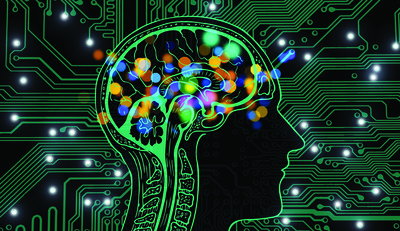INTERNET
Post-Coronavirus
With AI, a Workplace Safety Plan That Eases Fears
By Joe Dysart

New AI-powered systems are enabling businesses to keep workplaces Coronavirus-free.
As torrents of post-Coronavirus workers have returned to the office without masks—and at times with a lingering pang of uncertainty—some workplaces have been using artificial intelligence to protect their health against new outbreaks and variants of the scourge.
Essentially, these businesses have issued each employee a Bluetooth-enabled ID badge, which they use to track and analyze each employee’s movements throughout the day—and minimize their exposure to the virus.
Having such a solution enables Juniper Networks—both a maker of a Coronavirus monitoring system and a user—to quickly zero in on where a Coronavirus exposure occurs in the workplace and handle management of that potential exposure surgically.
“It allows us to quickly react,” says Brad Minnis, vice president of health safety and security and manager of the company’s ‘Juniper Mist,’ AI-powered Coronavirus monitoring system.
But it also “allows us also to limit the number of people that might be notified to those which are specifically at risk,” Minnis adds.
The Juniper system—one of many available from a number of vendors that specialize in employee tracking at the workplace:
- Uses thermal imaging to quickly detect fevers in employees as they enter the building.
- Uses other sensors to detect other indications of Coronavirus.
- Quickly messages an employee via smartphone who has been identified as potentially having Coronavirus.
- Quickly messages employees via smartphone if they have been in close proximity to an employee with a confirmed case of the Coronavirus.
- Minimizes workplace disruptions by messaging only those employees via smartphone who have been exposed to the Coronavirus—rather than attempting to ‘guess’ who might have been exposed to a Coronavirus-infected employee.
- Quickly messages a cleaning crew to immediately sanitize a Coronavirus-impacted area of the workplace.
- Verifies that all Coronavirus mitigation technology linked to the AI monitoring system—including enhanced air filtration systems—is operating at maximum efficiency.
Besides offering instant peace of mind to employees, probably one of the great benefits of Coronavirus workplace monitoring systems is that they enable a business to manage Coronavirus exposure with surgical precision—rather than blunt force.
In the early days of the Coronavirus, for example, businesses often shut down entire company campuses—which may have sported ten or more separate buildings of perhaps hundreds or thousands of people—after the report of even a single case of Coronavirus.
The reason: Flying blind, companies in the earliest days of the Coronavirus had no way of definitely knowing how one person—suddenly exhibiting signs of the Coronavirus—interacted with other employees at the workplace, journeyed through the rooms and buildings of the business campus and made decisions on where to linger most.
But with a system like Juniper’s, a company health and safety manager can immediately pull-up a complete record of a Coronavirus-impacted person’s journey through the workplace, identify exactly where they have been—and then issue an extremely precise health warning to only those employees who may have been exposed to the worker.
Says Minnis: “Now, if we have an individual on the seventh floor of a building who reported symptoms, we don’t have to send a message to everyone on the floor. With Juniper Mist, we can narrow the notifications to people who were directly in contact with the exposed individual.”
Yet another benefit: In many ways, software-based Coronavirus monitoring systems are often future-proofed. More often than not, new Coronavirus-sensing technologies can be hooked-up to existing Coronavirus monitoring systems as they’re invented.
Coronavirus researchers in Spain (www.sciencedirect.com/science/article/pii/S1746809421007722), for example, have come-up with new prototype technology that can identify—with 90% accuracy—whether or not a person has Coronavirus simply by the way a person coughs.
That kind of future technology, if developed, would come in handy if installed throughout a workplace—and especially handy at the entrances of businesses and in common areas where great numbers of employees congregate.
Besides serving as a relentless sentry on the virus, monitoring systems like Juniper’s also offer health and safety managers the flexibility to adjust employee use of the workplace as Coronavirus threats wax and wane.
With the lull in Coronavirus reported cases, for example, a workplace conference room might be perfectly safe for hosting up to 100 employees for important meetings.
But a health and safety manager may want to dial back the size of those congregations during any new high community transmissions of Coronavirus by alerting managers to limit meetings in those rooms to, say, just 20 people.
Plus, using the monitoring system, a health and safety manager would also have the ability to send ‘disperse’ smartphone reminders to employees should their numbers mistakenly swell above 20 people in Coronavirus-designated ‘hot zones.’
Minnis says companies adopting workplace Coronavirus monitoring will also most likely find that monitoring an entire workplace from one computer turns out to be a lot less expensive than some of the initial strategies used to get a handle on the virus.
Back in the early days of the Coronavirus, businesses sometimes resorted to posting numerous people at numerous locations throughout their business or company campus to keep an eye out for Coronavirus trouble—and serve as first warning communicators to employees at the first sign of a Coronavirus flare-up.
Maintaining a team of those kinds of people can be very expensive.
In contrast, one person using a software/sensor-based Coronavirus monitoring/alert system, can—over time—be a much more cost-effective solution.
Of course, probably the biggest hurdle businesses will need to deal with when deciding to onboard an AI-powered Coronavirus monitoring system is the privacy issue.
Essentially: At first blush, employees may like the idea of their company bringing in high-powered AI to safeguard their exposure to any new Coronavirus variants.
But they may also be leery of the ‘Big Brother’ feel of such a system—which monitors their every movement every second of their workday.
Systems like Juniper’s assuage those privacy concerns in part by setting their software to anonymize the identities of all employees monitored—until there is a Coronavirus detection and impacted personnel need to be immediately identified for their own safety.
Moreover, employee fears over privacy can been assuaged even further the first time Coronavirus flares-up in the workplace after the monitoring system is installed.
Absolute privacy becomes less of an employee ‘must-have,’ for example, if the nightly news in any given city is breathlessly reporting on the latest uptick from Coronavirus—while running 24/7 video of health officials issuing new warnings.
Says Minnis: “We are sensitive to both the individual’s privacy and trust—as well as our ability to manage and prevent the spread of infection for the safety of all our employees.”
When shopping for an AI-powered Coronavirus monitoring system, Juniper’s Mist is a good one to use as a benchmark.
But you’ll also want to take a look at other top employee location monitoring systems before making a final decision on a solution that’s right for you.
Fortunately, highly respected market research Gartner released a report in February 2022—“Magic Quadrant for Indoor Location Services” (www.gartner.com/doc/reprints?id=1-299NYK4W&ct=220228&st=sb)—which identifies the top vendors in employee location monitoring.
Those are:
- Zebra Technologies (www.zebra.com/us/en.html)
- Ubisense (https://ubisense.com/contact-tracing)
- Inpixon (www.inpixon.com/use-cases/health-safety)
- Juniper Networks (www.juniper.net/us/en/company/covid-19.html)
- AiRISTA (https://info.airistaflow.com/social-distancing-contact-tracing)
Joe Dysart is an internet speaker and business consultant based in Manhattan. 631-438-1142
joe@joedysart.com | www.joedysart.com








